GIS | Geographic Information Services
A division of Central Services
GIS Coordinator: Rachel Vaughan
Incident Map HelpDownload the Incident Map Users Guide [Pdf]
Quickstart Guide
|
| To search for an incident by case number, click on the small arrow which is located inside the search tool and select “Incidents”.After selecting the desired case number, the map will pan to the corresponding feature on the map and open the information dialog for that incident. |
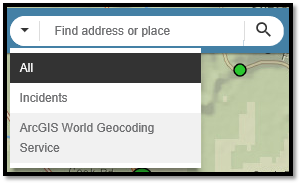 |
Next, enter the first few numbers of the case number and select a case number from the list that is displayed. If no numbers are displayed, the case number that is being entered may not exist in the map. 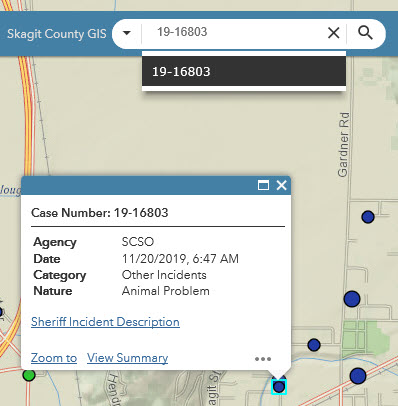 |
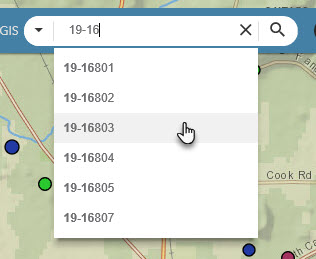 |
Search by Address or Place
| To Search for an address, click on the small arrow which is located inside the search tool and select “ArcGIS World Geocoding Service”. Next, enter the first few characters of the address or place and select an entry from the list that is displayed. |
 |
If no addresses or places are displayed, the address or place that is being entered may not exist in the map. After selecting the address or place, the map will pan to the corresponding location on the map and display an information dialog for the search result. 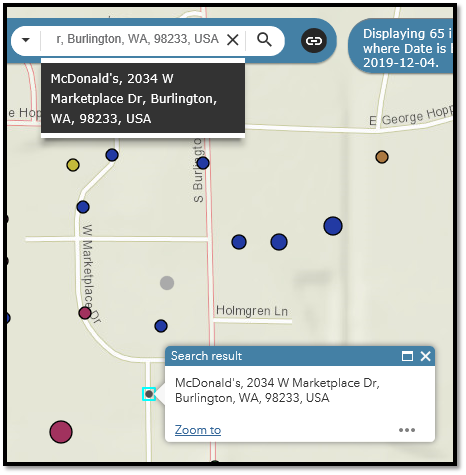 |
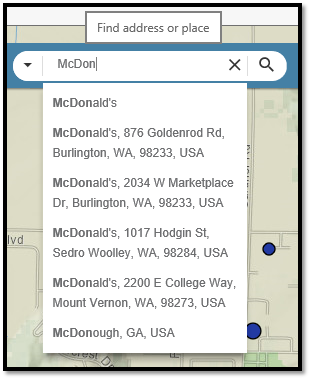 |
Area 2: Navigation
Use the tools in this area to move around the map.
Zoom InTo zoom the map in closer, click the “Zoom In” icon: |
Zoom OutTo zoom the map out further, click the “Zoom Out” icon: |
Zoom To Full ExtentTo zoom the map to the initial extent, click the “Zoom to Full Extent” icon: |
My LocationTo zoom to your current location, click the “My Location” icon: |
|
Area 3: The Toolbar

The Incident Map Toolbar has tools which help the user further explore incidents which have occurred in Skagit County. The Toolbar contains 6 tools which will be described in the following sections. The 6 tools (Legend, Layer List, Filter Tool, Info Summary, About, Bookmarks) are shown in the below screenshot.
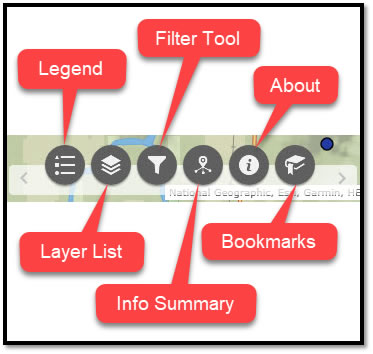 Each tool is represented by an icon which when clicked will open a window with additional information. When a tool icon has been clicked and the tool window is open, the Toolbar will display the icon in a slightly elevated location with a small black dot underneath the icon. When the tool window is open and the icon is displayed on the Toolbar with the small black dot below, clicking on the icon again will cause the tool window to close and the icon will be displayed in its original location without the small black dot beneath it. Multiple tool windows may be displayed at the same time. Each tool window has a minimize button and a close button. Clicking the minimize button in a tool window will cause that tool window to be displayed as the tool icon in the location where the tool window was displayed. The below screenshots show minimized tool windows and the Toolbar with elevated tool icons which represent open tool windows.
Each tool is represented by an icon which when clicked will open a window with additional information. When a tool icon has been clicked and the tool window is open, the Toolbar will display the icon in a slightly elevated location with a small black dot underneath the icon. When the tool window is open and the icon is displayed on the Toolbar with the small black dot below, clicking on the icon again will cause the tool window to close and the icon will be displayed in its original location without the small black dot beneath it. Multiple tool windows may be displayed at the same time. Each tool window has a minimize button and a close button. Clicking the minimize button in a tool window will cause that tool window to be displayed as the tool icon in the location where the tool window was displayed. The below screenshots show minimized tool windows and the Toolbar with elevated tool icons which represent open tool windows.
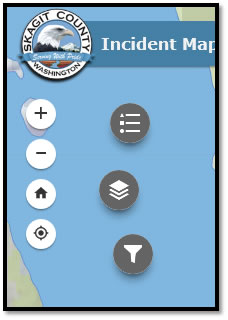

In the above screenshots, the “Legend” tool, the “Layer List” tool, and the “Filter” tool have all been opened and subsequently minimized.
Legend Window
Clicking on the “Legend” icon which is the first icon on the Toolbar will open the “Legend” window. This window provides the user with information on how features are being symbolized on the map.

Layer List Window
Clicking on the “Layer List” icon will open the “Layer List” window. This window provides the user with the ability to turn layers on or off, open the Attribute Table for each layer, and open a detailed description for each layer.
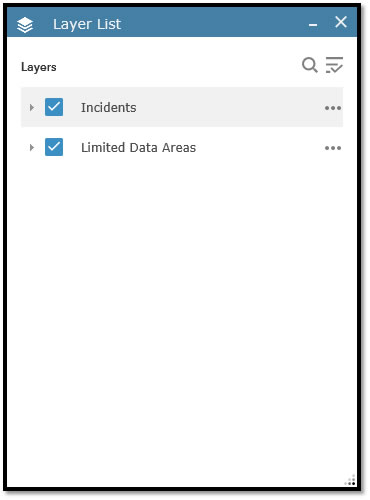
The screenshot below shows the options which are available when the user clicks on the options ellipsis for a layer which is listed in the “Layer List” window.
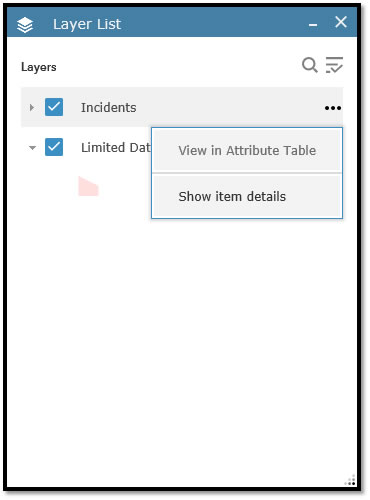
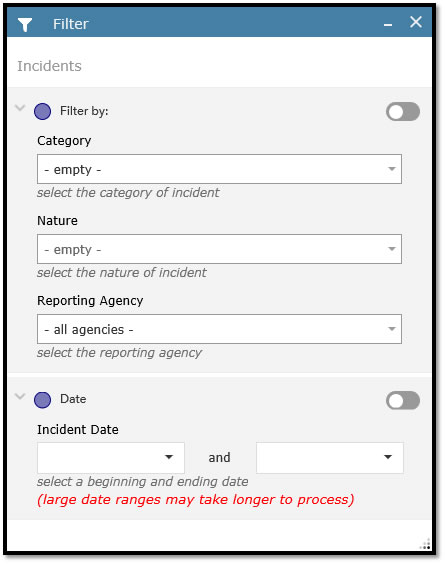 Filter Tool
Filter Tool
Clicking on the “Filter Tool” icon will open the “Filter Tool” window. This tool allows the user to filter the incidents which are displayed on the map by “Category”, “Nature”, “Reporting Agency”, and / or “Incident Date”. The “Filter Tool” is divided into 2 sections: “Filter by:” and “Date”. Each of these sections has a toggle switch in the upper right corner of the section. These toggle switches must be clicked for the filter criteria to be displayed.
To filter the incidents which are displayed, the user may select any combination of criteria. Once the criteria has been selected, the user must click on the toggle switch that is located in each section to apply the criteria selected in that section. The user may apply criteria from either section alone or both sections together.
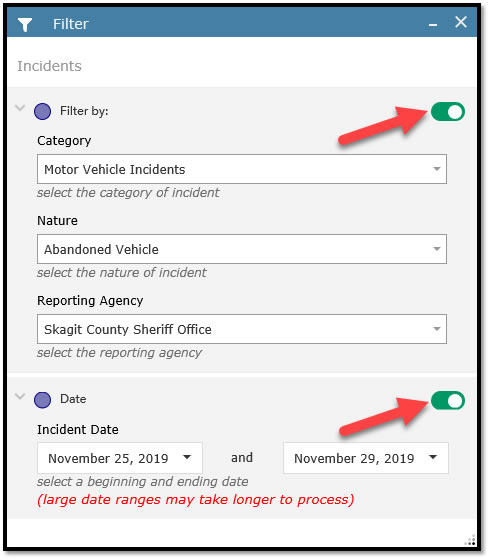
Info Summary
Clicking on the “Info Summary” icon will open the “Info Summary” window. This window displays a total for the number of incidents in the current map view and a break-down of incident categories with number of incidents in each category.
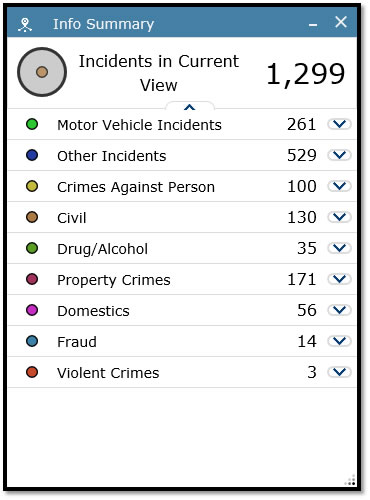
Selecting the dropdown arrow next to each category of incident will expand that section so that the user may see all incidents in the category as shown in the screenshot below.
Selecting the dropdown arrow next to each category of incident will expand that section so that the user may see all incidents in the category as shown in the screenshot below.
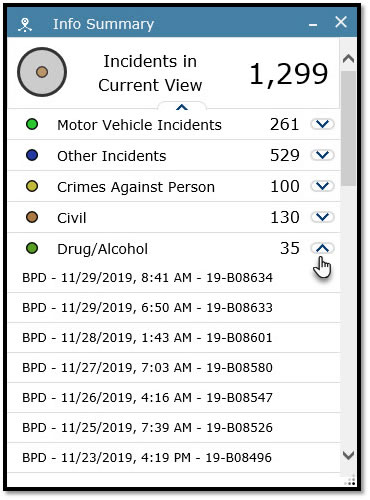
Selecting an individual incident in an expanded category will highlight the incident in the map display and open the information dialog for the selected incident as shown in the screenshot below.
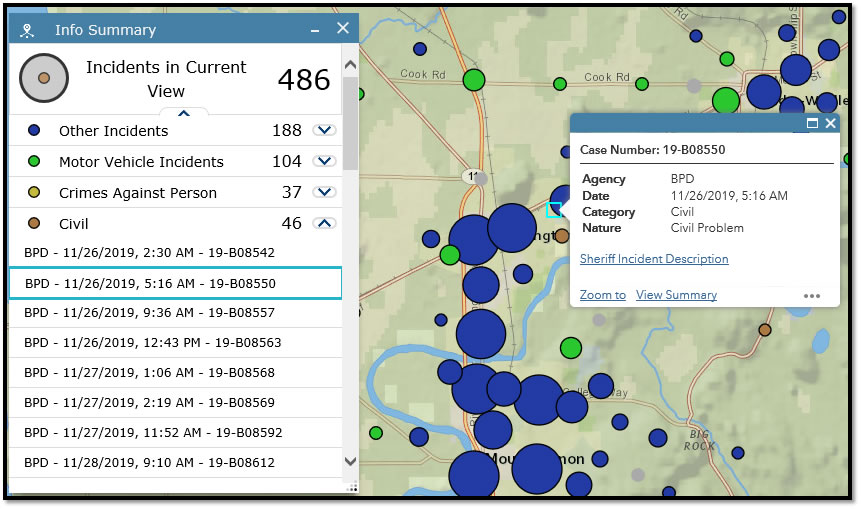
About Tool
Clicking on the “About” icon will open the “About” window. This window is used to provide additional information to the user about the Incident Map website.

Located towards the bottom of the information in the “About” window, the user will find contact information and links to the Skagit County website and terms and use for this website.

Bookmark Tool
The “Bookmark” tool provides a list of cities, towns, communities, and other areas within Skagit County which, when clicked, will zoom and center the map display to the selected area. To cause the map display to zoom and center, the user must click the icon which is displayed to the left of the area name. The user may also create their own bookmarks by clicking the “Add” button. To add a “Bookmark” the user should pan or zoom the map display to the area of interest prior to clicking the “Add” button. Once the “Add” button is clicked, the new bookmark will be displayed at the bottom of the “Bookmark” window and the user may edit the bookmark name and / or delete the bookmark.
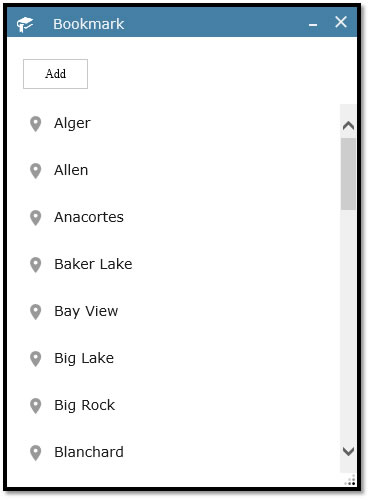
Area 4: The Scale Bar and Coordinate Display
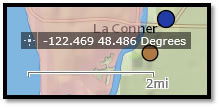
The Scale Bar and Coordinate Display area provides the user with a visual for determining distance on the map along with the latitude and longitude. As the user moves their mouse cursor over the map display, the Coordinate Display will provide the latitude and longitude of where the mouse cursor is located. The user may place a “Green” marker on the map at any location simply by clicking on the small button located at the left end of the Coordinate Display and then clicking on a location on the map. The user may continue selecting locations on the map until once again clicking on the small button.
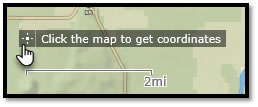
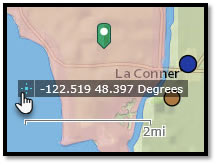
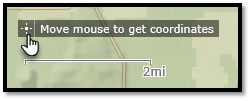
Area 5: The Attribute Table

The Attribute Table is where the user can view additional information about the incidents which are displayed in the current view. To open the Attribute Table, click on the Attribute Table icon. Another click on the icon will close the Attribute Table. When the Attribute Table is open, the user is provided with additional functionality as described below.

The user may select one of two tabs which are located at the top of the Attribute Table to change the layer for which attributes are being displayed. Below the layer tabs, the user is presented with a toolbar. On this toolbar, some functionality is displayed in a greyed-out fashion and will become available only when one or more records in the Attribute Table are selected. To select a record in the Attribute Table, the user must click on the small empty square located to the left of the record which the user wants to select. To select multiple records, the user must hold the shift key down while clicking on the small empty squares next to each record which they would like to select. The user may use the ctrl key to select records which are not adjacent to each other. When a record is selected in the Attribute Table the corresponding feature on the map display will also show as selected.
The screenshot below shows an Attribute Table with two selected records.
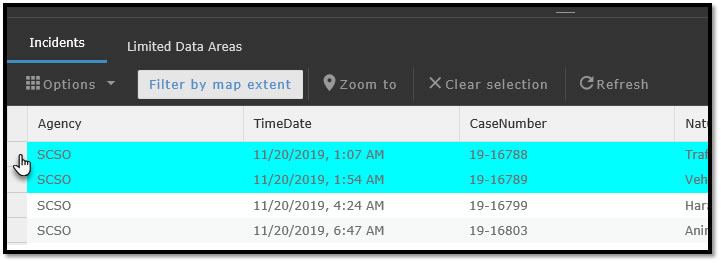
The Attribute Table toolbar
The Attribute Table toolbar has the following functionality:
Options

The Options dropdown allows the user to highlight selected records, filter records, show or hide columns, and export records to a comma-delimited file. The “Show selected records” option will remove all non-selected records from the Attribute Table. When this option has been selected, the text will change to “Show all records” and when it is selected again, all of the records will once again show in the Attribute Table. The “Filter” option will allow the user to apply criteria to the records which are displayed to select a subset of those records. The “Show/Hide columns” option will allow the user to customize the Attribute Table display by adding or removing columns. The “Export all to CSV” option allows the user to create a comma-delimited file of all the records. If there are selected records, this option changes to “Export selected to CSV” and will only export the selected records.
Filter by map extent
The “Filter by map extent” tool allows the user to toggle the records which are displayed between all incidents which are displayed on the map and only those incidents which are displayed in the current map extent.
Zoom to
The “Zoom to” tool is only available when one or more records have been selected. This tool will zoom the current map display to the extent of the selected records.
Clear selection
The “Clear selection” tool will unselect all selected records.
Refresh
The “Refresh” tool will refresh the records which are displayed.
Area 6: Incident Summary Note

The Incident Summary Note provides the user with valuable information pertaining to any Date Filters which have been applied to the view. The above Incident Summary Note screenshot shows that the Incidents in the current view occurred between November 19th, 2019 and December 3rd, 2019. The Incident Summary Note can be minimize by clicking the “X” which is located in the upper right corner of the note area.
The below screenshot shows what the Incident Summary Note looks like when it has been minimized. To reopen the note, just click the “X” a second time.

Area 7: Overview Map

The Overview Map icon will open a small map which shows a larger area around the current map view. The current map view is shown as a transparent grey rectangle in the center of the Overview Map. When the Overview Map is displayed, the Overview Map icon changes to resemble an “eye”. When the Overview Map is not displayed, the icon resembles an “eye” with a slash through it.
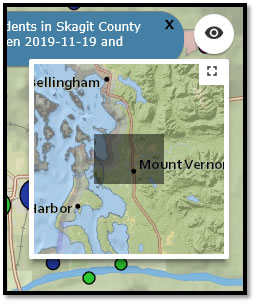
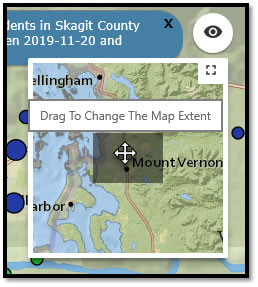
The user can use the Overview Map to move the current view to a different location. To move the current view, hover the mouse over the transparent grey rectangle until a “move” symbol appears. Once the “move” symbol appears, the user may press and hold the right mouse button and may drag the transparent grey rectangle to a different location on the Overview Map and the release the right mouse button. When the mouse button is released, the current map view will change to the new location.
The small broken square in the upper right corner of the Overview Map can be clicked to maximize the Overview Map. Clicking this square again will restore the Overview Map to its original size.
To close the Overview Map, click the Overview Map icon.
Download the Incident Map Users Guide [Pdf]






